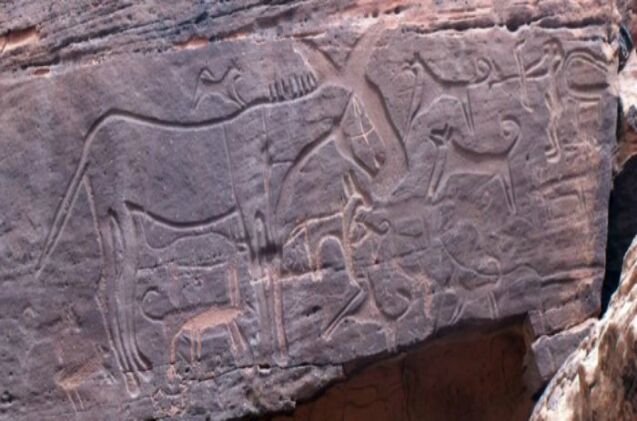Ancient Engravings Show Early Dogs Were Leashed Companions

I love history. And I love dogs. So I absolutely love the pictures from a new study that shows ancient man with 13 dogs by his side, and two of the dogs appear to be wearing leashes.
Related: Ancient Pet Cemetery Proves Egyptians Respected Their Family Fur Members
Melinda Zeder is an archeozoologist with the Smithsonian Institution National Museum of Natural History and says that the engravings most likely are about 8,000 years old and probably the earliest showings with dogs. More, the lines that connect the dogs from their necks to the man’s waist are probably the first depictions of a leashed animal. She says it’s astounding, as that suggests that humans were training and controlling dogs for thousands of years than has previously been thought, and specifically to hunt.
She says that obviously more work needs to be done to ensure the accuracy of both the age of the engravings and what they mean, but speaking preliminarily, the scenes from the Shuwaymis are remarkable.
The Shuwaymis are in Saudi Arabia. Maria Guagnin is with the Max Planck Institute for the Science of Human History in Jena Germany and has spent the last three years cataloging over 1400 rock art panels that have humans and over 7000 animals depicted.
About 10,000 years ago, hunter-gatherers appeared on the scenes, and then about 7000-8000 years ago, the panels started showing more herding pictures. They also looked at nearby region Jubbah, where they found livestock bones to match the pictures, and in the pictures, it seems are early hunting dogs in the engravings. At the Shuwaymis site, 156 dogs are shown, and the Jubbah panels show 193. The dogs all seem to be medium-sized, and have curled tails, short snouts and pricked up ears.
Related: Ancient Dogs Provide Clues About North America’s Early Inhabitants
In the panels, the dogs face off against wild animals, bite at others and are often depicted as tethered to a human bow and arrow hunter.
Co-author of the study Angela Perri has studied ancient dogs of the world and argued several times that dogs were pivotal to early hunting, despite much proof. She says these engravings are the closest thing to proof, short of a Youtube video, we may get.
Canaan dogs are feral dogs that roam the deserts of the Middle east and look remarkably like the ancient dogs. This may mean that those people bred dogs who already had hunting skills, or they could have done so independently from domesticated Arabian wolves.
Though all involved in the study agree that dating of images is tricky and still needs work done, they still are the oldest on record and date before Egyptian carvings. More, they are symbolic of either leashing and domestication as hunters or a bond between humans and dogs, and both are telling of how much early man depended on dogs, even then. That the dogs in the engravings had specific coat patterns and genders shows that they were important to the artists engraving.

More by Lori Ennis
























